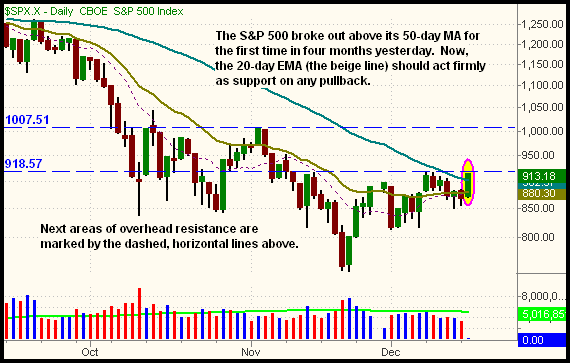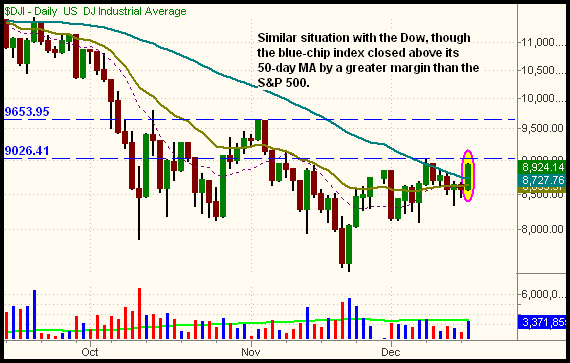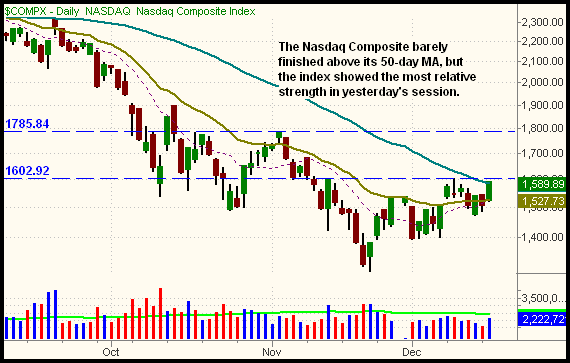|
The Wagner Daily ETF Report For December 17
After more than a week of deliberation between key support and resistance levels, the major indices convincingly broke out yesterday, closing above their 50-day moving averages for the first time in four months. Stocks gapped higher on the open, trended north throughout the morning, then kicked into overdrive upon the afternoon announcement that the Fed Funds Rate had been lowered to 0.5%. Though the half-point cut was widely expected, investors responded positively to the Fed's suggestion they were willing to take rates all the way down to zero if necessary. The Nasdaq Composite surged 5.4%, the S&P 500 5.1%, and the Dow Jones Industrial Average 4.2%. The small-cap Russell 2000 rocketed 6.7% higher, as the S&P Midcap 400 motored to a 6.1% gain. Bulls retained control into the closing bell, causing the main stock market indexes to finish at their best levels of the day.
Not surprisingly, turnover swelled across the board, enabling both the S&P 500 and Nasdaq Composite to score an "accumulation day" that was indicative of institutional buying. Total volume in the NYSE rose 23% above the previous day's level, while volume in the Nasdaq increased 31%. Unfortunately, volume still remained below 50-day average levels, but this could be attributed to seasonally light holiday volume in the latter half of December. Market internals were stellar. Advancing volume in the NYSE crushed declining volume by a margin of 16 to 1. The Nasdaq adv/dec volume ratio was similarly positive by 14 to 1.
The ability of the major indices to close above their 50-day moving averages for the first time since August confirms the change to bullish sentiment we have been observing in recent weeks. Since mutual funds, hedge funds, and other institutions commonly use the 50-day moving average as an indicator for intermediate-term trend direction, program trading on the buy side could send the market significantly higher in the coming weeks. Nevertheless, since the major indices remain in long-term downtrends, we still cannot classify the current strength as more than a tradeable, counter-trend bounce. Regardless, as we mentioned a few days ago, it makes sense to take advantage of the strength while it lasts.
To get an educated idea of just how long this rally may last before running out of gas, let's take an updated look at daily charts of the S&P 500, Dow Jones Industrial Average, and Nasdaq Composite. First is the chart of the benchmark S&P 500 Index:

The two dashed, horizontal lines on the chart above represent the next areas of price resistance for the S&P 500. The first, at the 919 level, is formed by the prior highs of last week's breakout above the 20-day exponential moving average (the beige line). At just 0.7% above yesterday's closing price, it's unlikely this level will offer much resistance, but it's notable nevertheless. Odds are good that short-term momentum of yesterday's breakout above the 50-day moving average (the teal line) will enable the S&P 500 to move above the 919 level within the next few days. The next major area of resistance is the vicinity of the November 4 high, just over the 1,000 level (10% above the current price). If the index has enough mojo to rally to its November high, it's a good point to sell any long positions into strength, or at least trail tight protective stops to protect profits. At that time, we'll re-assess market conditions to determine whether it's time to jump back in on the short side of the market, or just hang loose in anticipation of further strength. Next, take a look at the daily chart of the blue-chip Dow Jones Industrial Average:

As with the S&P 500, the Dow also has resistance just above its current price, at the 9,026 area. With a similar overall pattern to the S&P 500, the November 4 high of 9,654 will be a significant level of price resistance in the intermediate-term. Again, any approach of the November high presents an ideal place to sell long positions into strength (assuming the rally doesn't fizzle out before then). Finally, here's the Nasdaq Composite:

Surprise! The Nasdaq chart pattern resembles those of the S&P and Dow. 1,603 is the very short-term resistance, while the November high is at 1,786. Again, if trading in the Nasdaq, one could follow the same plan of selling into strength and/or getting short on a test of the November high. For all three of the major indexes, all bets are off on the long side of the market if any of the major indices suddenly reverse to close below key support of their December 12 "swing lows." Such price action would be representative of a failed breakout, which would be quite bearish if it occurs at the 50-day moving averages.
Presently, we have four open ETF positions in our model account (FXI, INP, SMH, and QLD). All are now showing a nice profit since their entry points, which range from December 5 to 12. However, we plan to continually trail stops higher in the coming days, so as not to be complacent about the market's likelihood of moving higher. When positions begin trending steadily, support of the 20-period exponential moving average on the hourly chart interval is a good guideline for trailing stops higher. This is discussed more thoroughly in my book, Trading ETFs: Gaining An Edge With Technical Analysis. Though the overall market is acting better than it has for months, don't fall in love with your positions. Above all, remember to trade what you see, not what you think!
Open ETF positions:
Long - QLD, FXI, INP, SMH
Short - (none)
Deron Wagner is the Founder and Head Trader of both Morpheus Capital LP, a U.S. hedge fund, and Morpheus Trading Group, a trader education firm launched in 2001 that provides daily technical analysis of the leading ETFs and stocks. For a free trial to the full version of The Wagner Daily or to learn about Wagner's other services, visit MorpheusTrading.com or send an e-mail to deron@morpheustrading.com.
|